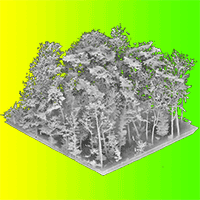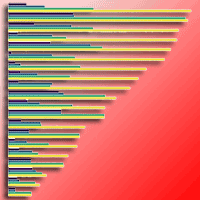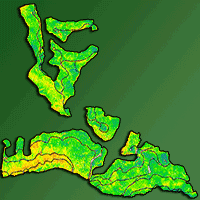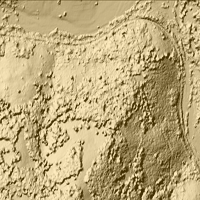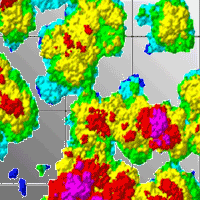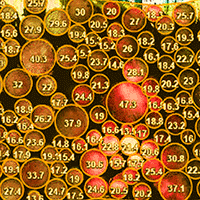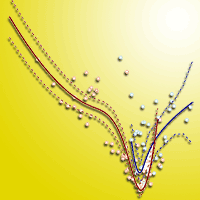The provision of ecosystem functions and services in forests is closely linked to the presence of complex structures. One such service is the ability to store carbon. It has recently become possible to quantify both structural complexity and biomass of forests (as proxy of carbon storage) using light detection and ranging (LiDAR). The objective of this study was to analyze how the community-level complexity of a forest stand relates to structural characteristics, and biomass in particular, of the trees comprising the stand. To do so, we virtually assembled 30 forests (3D models), all representing different versions of a beech-pine forest in Germany, based on real world 3D LiDAR scan data of all trees in the forest. At the individual tree level, various structural characteristics, including wood volume and biomass were derived using both voxel models and quantitative structure models (QSM). Basal area and biomass, as well as to a lower degree also the mean height of maximum crown projection area, significantly affected the structural complexity at stand level. Among the different forest models, the variation in complexity could best be described using a combination of basal area, mean height of the maximum crown projection area, and the coefficient of variation of total tree height. Biomass alone explained 54% of the variation in stand-level complexity, while the multivariate model based on measures addressing the amount and vertical distribution of plant material explained 86% of the variability in complexity. Using a laser-based and holistic approach of assessing the structural complexity, namely the box-dimension, allowed identifying key structural attributes that promote aboveground structural complexity of the forest studied here.
Keywords
, , , , ,
Citation
Seidel D, Böttger FA (2023). How biomass and other tree architectural characteristics relate to the structural complexity of a beech-pine forest. iForest 16: 368-376. - doi: 10.3832/ifor4305-016
Academic Editor
Francesco Ripullone
Paper history
Received: Jan 12, 2023
Accepted: Nov 04, 2023
First online: Dec 19, 2023
Publication Date: Dec 31, 2023
Publication Time: 1.50 months
© SISEF - The Italian Society of Silviculture and Forest Ecology 2023
Open Access
This article is distributed under the terms of the Creative Commons Attribution-Non Commercial 4.0 International (https://creativecommons.org/licenses/by-nc/4.0/), which permits unrestricted use, distribution, and reproduction in any medium, provided you give appropriate credit to the original author(s) and the source, provide a link to the Creative Commons license, and indicate if changes were made.

Breakdown by View Type
(Waiting for server response...)
Article Usage
Total Article Views: 16236
(from publication date up to now)
Breakdown by View Type
HTML Page Views: 12378
Abstract Page Views: 2273
PDF Downloads: 1290
Citation/Reference Downloads: 4
XML Downloads: 291
Web Metrics
Days since publication: 727
Overall contacts: 16236
Avg. contacts per week: 156.33
Article Citations
Article citations are based on data periodically collected from the Clarivate Web of Science web site
(last update: Mar 2025)
Total number of cites (since 2023): 1
Average cites per year: 0.33
Publication Metrics
by Dimensions ©
Articles citing this article
List of the papers citing this article based on CrossRef Cited-by.
(1)
Ammer C (2019)Diversity and forest productivity in a changing climate. New Phytologist 221 (1): 50-66.
CrossRef |
Gscholar
(2)
Badreldin N, Sanchez-Azofeifa A, Baghdadi N, Thenkabail PS (2015)Estimating forest biomass dynamics by integrating multi-temporal Landsat satellite images with ground and airborne LiDAR data in the Coal Valley Mine, Alberta, Canada. Remote Sensing 7 (3): 2832-2849.
CrossRef |
Gscholar
(3)
Calders K, Newnham G, Burt A, Murphy S, Raumonen P, Herold M, Culvenor D, Avitabile V, Disney M, Armston J, Kaasalainen M (2015)Nondestructive estimates of above-ground biomass using terrestrial laser scanning. Methods in Ecology and Evolution 6 (2): 198-208.
CrossRef |
Gscholar
(4)
Chapin III FS, Kofinas GP, Folke C, Chapin MC (2009)Principles of ecosystem stewardship: resilience-based natural resource management in a changing world. Springer Science and Business Media, New York, USA, pp. 401.
Online |
Gscholar
(5)
Chiba Y (1998)Architectural analysis of relationship between biomass and basal area based on pipe model theory. Ecological Modelling 108 (1-3): 219-225.
CrossRef |
Gscholar
(6)
Demol M, Verbeeck H, Gielen B, Armston J, Burt A, Disney M, Duncanson L, Hackenberg J, Kükenbrink D, Lau A, Ploton P, Sewdien A, Stovall A, Takoudjou SM, Volkova L, Weston C, Wortel V, Calders K (2022)Estimating forest above-ground biomass with terrestrial laser scanning: current status and future directions. Methods in Ecology and Evolution 13 (8): 1628-1639.
CrossRef |
Gscholar
(7)
Disney MI, Boni Vicari M, Burt A, Calders K, Lewis SL, Raumonen P, Wilkes P (2018)Weighing trees with lasers: advances, challenges and opportunities. Interface Focus 8 (2): 20170048.
CrossRef |
Gscholar
(8)
Dorji Y, Annighöfer P, Ammer C, Seidel D (2019)Response of beech (
Fagus sylvatica L.) trees to competition new insights from using fractal analysis. Remote Sensing 11 (22): 2656.
CrossRef |
Gscholar
(9)
Dorji Y, Schuldt B, Neudam L, Dorji R, Middleby K, Isasa E, Körber K, Ammer C, Annighöfer P, Seidel D (2021)Three-dimensional quantification of tree architecture from mobile laser scanning and geometry analysis. Trees 35: 1385-1398.
CrossRef |
Gscholar
(10)
Douinot A, Tetzlaff D, Maneta M, Kuppel S, Schulte-Bisping H, Soulsby C (2019)Ecohydrological modelling with EcH
2O-iso to quantify forest and grassland effects on water partitioning and flux ages. Hydrological Processes 33 (16): 2174-2191.
CrossRef |
Gscholar
(11)
Ehbrecht M, Schall P, Ammer C, Seidel D (2017)Quantifying stand structural complexity and its relationship with forest management, tree species diversity and microclimate. Agricultural and Forest Meteorology 242: 1-9.
CrossRef |
Gscholar
(12)
Ehbrecht M, Seidel D, Annighöfer P, Kreft H, Köhler M, Zemp DC, Puettmann K, Nilus R, Babweteera F, Willim K, Stiers M, Soto D, Boehmer HJ, Fisichelli N, Burnett M, Juday G, Stephens SL, Ammer C (2021)Global patterns and climatic controls of forest structural complexity. Nature Communications 12 (1): 135719.
CrossRef |
Gscholar
(13)
Feldmann E, Glatthorn J, Hauck M, Leuschner C (2018)A novel empirical approach for determining the extension of forest development stages in temperate old-growth forests. European Journal of Forest Research 137: 321-335.
CrossRef |
Gscholar
(14)
Gadow KV, Zhang CY, Wehenkel C, Pommerening A, Corral-Rivas J, Korol M, Myklush S, Hui GY, Kiviste A, Zhao XH (2012)Forest structure and diversity. In: “Continuous Cover Forestry” (Pukkala T, von Gadow K eds). Managing Forest Ecosystems, vol. 23, Springer, Dordrecht, Netherlands, pp. 29-83.
CrossRef |
Gscholar
(15)
GeoSLAM (2021)ZEB Horizon: the ultimate mobile mapping tool - Product Sheet. Geoslam Ltd., Nottingham, UK, pp. 1.
Online |
Gscholar
(16)
Hackenberg J, Morhart C, Sheppard J, Spiecker H, Disney M (2014)Highly accurate tree models derived from terrestrial laser scan data: a method description. Forests 5: 1069-1105.
CrossRef |
Gscholar
(17)
Hackenberg J, Spiecker H, Calders K, Disney M, Raumonen P (2015a)SimpleTree - An efficient open source tool to build tree models from TLS clouds. Forests 6 (11): 4245-4294.
CrossRef |
Gscholar
(18)
Hackenberg J, Wassenberg M, Spiecker H, Sun D (2015b)Non destructive method for biomass prediction combining TLS derived tree volume and wood density. Forests 6 (4): 1274-1300.
CrossRef |
Gscholar
(19)
Hardiman BS, Bohrer G, Gough CM, Vogel CS, Curtis PS (2011)The role of canopy structural complexity in wood net primary production of a maturing northern deciduous forest. Ecology 92 (9): 1818-1827.
CrossRef |
Gscholar
(20)
Hector A, Bagchi R (2007)Biodiversity and ecosystem multifunctionality. Nature 448 (7150): 188-190.
CrossRef |
Gscholar
(21)
Heidenreich MG, Seidel D (2022)Assessing forest vitality and forest structure using 3D data: a case study from the Hainich National Park, Germany. Frontiers in Forests and Global Change 5: 7063.
CrossRef |
Gscholar
(22)
Hember RA, Kurz WA (2018)Low tree-growth elasticity of forest biomass indicated by an individual-based model. Forests 9 (1): 21.
CrossRef |
Gscholar
(23)
Hemery GE, Savill PS, Pryor SN (2005)Applications of the crown diameter-stem diameter relationship for different species of broadleaved trees, Forest Ecology and Management 215 (1-3): 285-294.
CrossRef |
Gscholar
(24)
Juchheim J, Ammer C, Schall P, Seidel D (2017)Canopy space filling rather than conventional measures of structural diversity explains productivity of beech stands. Forest Ecology and Management 395: 19-26.
CrossRef |
Gscholar
(25)
Juchheim J, Ehbrecht M, Schall P, Ammer C, Seidel D (2020)Effect of tree species mixing on stand structural complexity. Forestry 93 (1): 75-83.
CrossRef |
Gscholar
(26)
Jucker T, Bouriaud O, Coomes DA (2015)Crown plasticity enables trees to optimize canopy packing in mixed-species forests. Functional Ecology 29 (8): 1078-1086.
CrossRef |
Gscholar
(27)
Keles S (2016)Optimum cutting ages in hybrid poplar plantations including carbon sequestration: a case study in Turkey. Revista Chapingo - Serie Ciencias Forestales y del Ambiente 22 (3): 339-349.
CrossRef |
Gscholar
(28)
Kint V, Robert DW, Noël L (2004)Evaluation of sampling methods for the estimation of structural indices in forest stands. Ecological Modelling 180 (4): 461-476.
CrossRef |
Gscholar
(29)
Knigge W, Schulz H (1966)Grundriss der Forstbenutzung [Outline of forest utilization: origin, properties, utilization and use of wood and other forest products]. Parey Verlag, Hamburg, Germany, pp. 584. [in German]
Gscholar
(30)
Kollmann F (1982)Technologie des Holzes und der Holzwerkstoffe [Technology of wood and wood-based materials]. Series 1, Springer Verlag, Berlin, Germany, pp. 1051. [in German]
Gscholar
(31)
LeBauer DS, Treseder KK (2008)Nitrogen limitation of net primary productivity in terrestrial ecosystems is globally distributed. Ecology 89 (2): 371-379.
CrossRef |
Gscholar
(32)
Lines ER, Fischer FJ, Owen HJF, Jucker T (2022)The shape of trees: reimagining forest ecology in three dimensions with remote sensing. Journal of Ecology 110: 1730-1745.
CrossRef |
Gscholar
(33)
Mandelbrot BB (1977)The fractal geometry of nature. W.H. Freeman Company, New York, USA. pp. 508.
Gscholar
(34)
Mayr E (1998)This is biology - The science of the living world. Belknap Press of Harvard University Press, Cambridge, MA, USA, pp. 344.
Online |
Gscholar
(35)
Messier C, Puettmann KJ, Coates KD (2013)Managing forests as complex adaptive systems - Introductory concepts and applications. In: “Managing Forests as Complex Adaptive Systems: Building Resilience to the Challenge of Global Change” (Messier C, Puettmann K, Coates KD eds). Routledge, London, UK, pp. 3-16.
CrossRef |
Gscholar
(36)
Metz JO, Seidel D, Schall P, Scheffer D, Schulze ED, Ammer C (2013)Crown modeling by terrestrial laser scanning as an approach to assess the effect of aboveground intra- and interspecific competition on tree growth. Forest Ecology and Management 310: 275-288.
CrossRef |
Gscholar
(37)
Neudam L, Annighöfer P, Seidel D (2022)Exploring the potential of mobile laser scanning to quantify forest structural complexity. Frontiers in Remote Sensing 3: 3.
CrossRef |
Gscholar
(38)
O’Brien ST, Hubbell SP, Spiro P, Condit R& Foster RB (1995)Diameter, height, crown, and age relationship in eight neotropical tree species. Ecology 76: 1926-1939.
CrossRef |
Gscholar
(39)
Pretzsch H, del Río M, Schütze G, Ammer C, Annighöfer P, Avdagic A, Barbeito I, Bielak K, Brazaitis G, Coll L, Drössler L, Fabrika M, Forrester D, Kurylyak V, Löf M, Lombardi F, Matović B, Mohren F, Motta R, den Ouden J, Pach M, Ponette Q, Skrzyszewski J, Sramek V, Sterba H, Svoboda M, Verheyen K, Zlatanov T, Bravo-Oviedo A (2016)Mixing of Scots pine (
Pinus sylvestris L.) and European beech (
Fagus sylvatica L.) enhances structural heterogeneity, and the effect increases with water availability. Forest Ecology and Management 373 (4): 149-166.
CrossRef |
Gscholar
(40)
Puettmann KJ, Coates KD, Messier CC (2012)A critique of silviculture: managing for complexity. Island press, Washington, DC, USA, pp. 208.
Online |
Gscholar
(41)
Raumonen P, Casella E, Calders K, Murphy S, Akerblom M, Kaasalainen M (2015)Massive-scale tree modelling from TLS data. ISPRS Annals of the Photogrammetry, Remote Sensing and Spatial Information Sciences II-3/W4: 189-196.
CrossRef |
Gscholar
(42)
Raumonen P, Kaasalainen M, Markku A, Kaasalainen S, Kaartinen H, Vastaranta M, Holopainen M, Disney M, Lewis P (2013)Fast automatic precision tree models from terrestrial laser scanner data. Remote Sensing 5 (2): 491-520.
CrossRef |
Gscholar
(43)
R Core Team (2022)R: a language and environment for statistical computing. R Foundation for Statistical Computing, Vienna, Austria.
Online |
Gscholar
(44)
Schulte-Bisping H, Beese F (2016)N-fluxes and N-turnover in a mixed beech-pine forest under low N-inputs. European Journal of Forest Research 135 (2): 229-241.
CrossRef |
Gscholar
(45)
Schulte-Bisping H, Beese F, Dieffenbach-Fries H (2012)C-fluxes and C-turnover of a mature mixed beech and pine stand under increasing temperature at ICP Integrated Monitoring site in Neuglobsow (Brandenburg). European Journal of Forest Research 131 (5): 1601-1609.
CrossRef |
Gscholar
(46)
Saarinen N, Calders K, Kankare V, Yrttimaa T, Junttila S, Luoma V, Huuskonen S, Hynynen J, Verbeeck H (2021)Understanding 3D structural complexity of individual Scots pine trees with different management history. Ecology and Evolution 11 (6): 2561-2572.
CrossRef |
Gscholar
(47)
Seidel D, Leuschner C, Müller A, Krause B (2011)Crown plasticity in mixed forests - Quantifying asymmetry as a measure of competition using terrestrial laser scanning. Forest Ecology and Management 261 (11): 2123-2132.
CrossRef |
Gscholar
(48)
Seidel D, Schall P, Gille M, Ammer C (2015)Relationship between tree growth and physical dimensions of
Fagus sylvatica crowns assessed from terrestrial laser scanning. iForest 8: 735-742.
CrossRef |
Gscholar
(49)
Seidel D (2018)A holistic approach to determine tree structural complexity based on laser scanning data and fractal analysis. Ecology and Evolution 8: 128-134.
CrossRef |
Gscholar
(50)
Seidel D, Ehbrecht M, Annighöfer P, Ammer C (2019a)From tree to stand-level structural complexity Which properties make a forest stand complex? Agricultural and Forest Meteorology 278 (1): 107699.
CrossRef |
Gscholar
(51)
Seidel D, Ehbrecht M, Dorji Y, Jambay J, Ammer C, Annighöfer P (2019b)Identifying architectural characteristics that determine tree structural complexity. Trees - Structure and Function 33 (3): 911-919.
CrossRef |
Gscholar
(52)
Seidel D, Annighöfer P, Ehbrecht M, Magdon P, Wöllauer S, Ammer C (2020)Deriving stand structural complexity from airborne laser scanning data-what does it tell us about a forest? Remote Sensing 12 (11): 1854.
CrossRef |
Gscholar
(53)
Seidel D, Annighöfer P, Ammer C, Ehbrecht M, Willim K, Bannister J, Soto DP (2021)Quantifying understory complexity in unmanaged forests using TLS and identifying some of its major drivers. Remote Sensing 13 (8): 1513.
CrossRef |
Gscholar
(54)
Seidel D, Ammer C (2023)Towards a causal understanding of the relationship between structural complexity, productivity, and adaptability of forests based on principles of thermodynamics. Forest Ecology and Management 544 (4): 121238.
CrossRef |
Gscholar
(55)
Stiers M, Annighöfer P, Seidel D, Willim K, Neudam L, Ammer C (2020)Quantifying the target state of forest stands managed with the continuous cover approach - revisiting Möller’s “Dauerwald” concept after 100 years. Trees, Forests and People 1: 100004.
CrossRef |
Gscholar
(56)
Way DA, Oren R (2010)Differential responses to changes in growth temperature between trees from different functional groups and biomes: a review and synthesis of data. Tree Physiology 30 (6): 669-688.
CrossRef |
Gscholar
(57)
Willim K, Stiers M, Annighöfer P, Ehbrecht M, Ammer C, Seidel D (2020)Spatial patterns of structural complexity in differently managed and unmanaged beech-dominated forests in Central Europe. Remote Sensing 12 (12): 1907.
CrossRef |
Gscholar
(58)
Williams LJ, Paquette A, Cavender-Bares J, Messier C, Reich PB (2017)Spatial complementarity in tree crowns explains overyielding in species mixtures. Nature Ecology and Evolution 1 (4): 1-7.
CrossRef |
Gscholar
(59)
Wittkopf S (2004)Bereitstellung von Hackgut zur thermischen Verwertung durch Forstbetriebe in Bayern [Provision of wood chips for thermal utilization by forestry operations in Bavaria]. Dissertation, Technical University Munich, Munich, Germany. pp. 217. [in German]
Online |
Gscholar
(60)
Zenner EK, Hibbs DE (2000)A new method for modeling the heterogeneity of forest structure. Forest Ecology and Management 129 (1-3): 75-87.
CrossRef |
Gscholar
(61)
Zhu X, Liu D (2015)Improving forest aboveground biomass estimation using seasonal Landsat NDVI time-series. ISPRS Journal of Photogrammetry and Remote Sensing 102: 222-231.
CrossRef |
Gscholar
